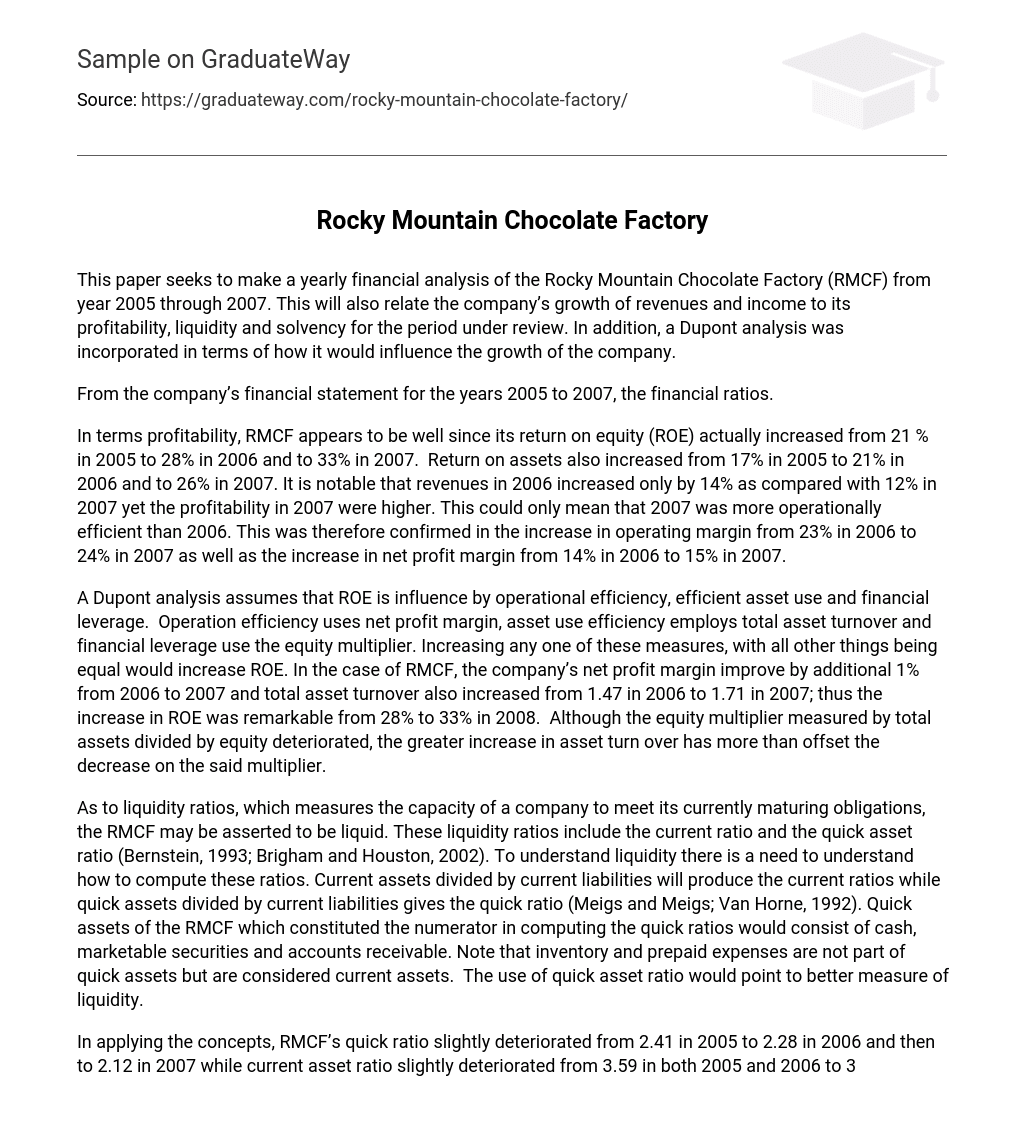This paper seeks to make a yearly financial analysis of the Rocky Mountain Chocolate Factory (RMCF) from year 2005 through 2007. This will also relate the company’s growth of revenues and income to its profitability, liquidity and solvency for the period under review. In addition, a Dupont analysis was incorporated in terms of how it would influence the growth of the company.
From the company’s financial statement for the years 2005 to 2007, the financial ratios. In terms profitability, RMCF appears to be well since its return on equity (ROE) actually increased from 21 % in 2005 to 28% in 2006 and to 33% in 2007. Return on assets also increased from 17% in 2005 to 21% in 2006 and to 26% in 2007.
It is notable that revenues in 2006 increased only by 14% as compared with 12% in 2007 yet the profitability in 2007 were higher. This could only mean that 2007 was more operationally efficient than 2006. This was therefore confirmed in the increase in operating margin from 23% in 2006 to 24% in 2007 as well as the increase in net profit margin from 14% in 2006 to 15% in 2007.
A Dupont analysis assumes that ROE is influence by operational efficiency, efficient asset use and financial leverage. Operation efficiency uses net profit margin, asset use efficiency employs total asset turnover and financial leverage use the equity multiplier. Increasing any one of these measures, with all other things being equal would increase ROE.
In the case of RMCF, the company’s net profit margin improve by additional 1% from 2006 to 2007 and total asset turnover also increased from 1.47 in 2006 to 1.71 in 2007; thus the increase in ROE was remarkable from 28% to 33% in 2008. Although the equity multiplier measured by total assets divided by equity deteriorated, the greater increase in asset turn over has more than offset the decrease on the said multiplier.
As to liquidity ratios, which measures the capacity of a company to meet its currently maturing obligations, the RMCF may be asserted to be liquid. These liquidity ratios include the current ratio and the quick asset ratio (Bernstein, 1993; Brigham and Houston, 2002). To understand liquidity there is a need to understand how to compute these ratios. Current assets divided by current liabilities will produce the current ratios while quick assets divided by current liabilities gives the quick ratio (Meigs and Meigs; Van Horne, 1992).
Quick assets of the RMCF which constituted the numerator in computing the quick ratios would consist of cash, marketable securities and accounts receivable. Note that inventory and prepaid expenses are not part of quick assets but are considered current assets. The use of quick asset ratio would point to better measure of liquidity.
In applying the concepts, RMCF’s quick ratio slightly deteriorated from 2.41 in 2005 to 2.28 in 2006 and then to 2.12 in 2007 while current asset ratio slightly deteriorated from 3.59 in both 2005 and 2006 to 3.30 in 2007. Both ratios have shown decreasing trend and the same must be surprising because increase in profitability in 2008. Operations normally generate profits and funds that should make a company more liquid. As to company’s solvency ratios that measure its long-term health risk, RMCF’s debt to equity ratio, after declining from 2005, improved from 0.24 in 2006 to 0.21 in 2007.
It can be concluded that the improvement in company’s solvency is very much consistent with the increase in profitability in 2007 as compared to 2006. As compared further with the deterioration in liquidity, it may be deduced that the company has decided to prioritize its long-term health. But since the liquidity ratios are still high despite the slight decrease in current ratio and quick ratio for the same period, it can be safely concluded that the decision of the company is still very much justified since it would mean making the company more stable but at the same time maintaining its very liquid position.
References
- Bernstein (1993) Financial Statement Analysis, IRWIN, Sydney, Australia
- Brigham and Houston (2002) Fundamentals of Financial Management, Thomson South-Western, London, UK
- Rocky Mountain Chocolate Factory (2008) Company Website, {www document} URL www.rmcf.com, Accessed November 18, 2008-11-19
- Yahoo Finance (2008a) Income Statement, 2005 to 2007, {www document} URL http://finance.yahoo.com/q/is?s=RMCF&annual, Accessed November 18, 2008
- Yahoo Finance (2008b) Balance Sheet 2005 to 2007, {www document} URL http://finance.yahoo.com/q/bs?s=RMCF&annual, Accessed November 18, 2008
- Case Study – Rocky Mountain Chocolate Factory
- Meigs and Meigs (1995) Financial Accounting, McGraw-Hill, New York, USA
- Van Horne (1992) Financial Management and Policy, Prentice-Hall International, London, UK





